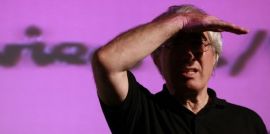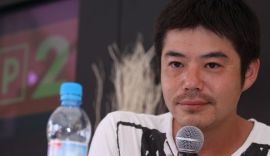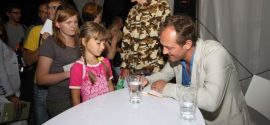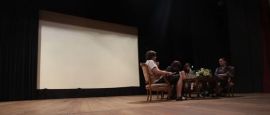A spectator’s eye view: Gospel according to Majewski
 For me Lech Majewski is the greatest contemporary ‘painter’ of the cinema. And it’s not only because he studied at the Academy of Fine Arts, and often refers to subjects connected with painting in his films- like in ‘The Garden of Earthly Delights’, for which Majewski derived the title and leitmotif from Bosch’s famous painting. He is the painter of the cinema because he is able to transfer to the film language all the beauty, harmony and symmetry which used to be portrayed by great masters in their paintings- especially by the Renaissance, ‘Venetian’ masters. What’s more, he is able to adapt the entire poetics of the 19th century painting to the contemporary world. That’s most appreciated about him around the world. I wonder why in Poland his name isn’t mentioned in the same breath as the greatest Polish filmmakers’ names? Maybe it’s because he surpasses them, or doesn’t try to curry favor with the so-called entourage – which, as a matter of fact, knows well enough that Majewski, together with Polański, is one of the most recognized Polish film directors in the world, especially in the USA.
For me Lech Majewski is the greatest contemporary ‘painter’ of the cinema. And it’s not only because he studied at the Academy of Fine Arts, and often refers to subjects connected with painting in his films- like in ‘The Garden of Earthly Delights’, for which Majewski derived the title and leitmotif from Bosch’s famous painting. He is the painter of the cinema because he is able to transfer to the film language all the beauty, harmony and symmetry which used to be portrayed by great masters in their paintings- especially by the Renaissance, ‘Venetian’ masters. What’s more, he is able to adapt the entire poetics of the 19th century painting to the contemporary world. That’s most appreciated about him around the world. I wonder why in Poland his name isn’t mentioned in the same breath as the greatest Polish filmmakers’ names? Maybe it’s because he surpasses them, or doesn’t try to curry favor with the so-called entourage – which, as a matter of fact, knows well enough that Majewski, together with Polański, is one of the most recognized Polish film directors in the world, especially in the USA.
„Gospel according to Harry” is Majewski’s another film, after „Flight of the Spruce Goose”, made in the USA. Actually the film was made in Łeba but Americans gave the money to produce it (Poland became the official co-producer). Majewski still tells stories of how he travelled over 5,000 miles in search of suitable locations in America, only to find them on the Polish coast. The acting is a strong point of the film. It’s worth mentioning that the role of Wes was played by an actor not-too-well-known then, Vigo Mortensen.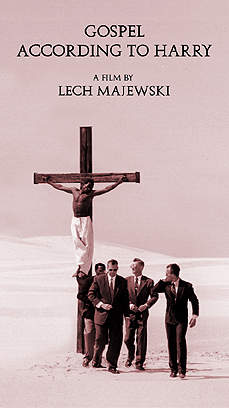 The very idea of the film is ingenious, the idea of wondering about how the Gospel would look like if it was written today. What problems would the ‘holy’ family experience (or is experiencing?) before the birth of a child so longed for (but probably longed for only by the mother). It’s necessary to say that Majewski wasn’t interested in the religious context. He focused exclusively on the relationship and on the influence of family and surrounding on it. And as it often happens in his film, he used innovative means to do it. The action takes place on a desert where the two heroes ‘live’. This technique, brilliant in its simplicity and strongly affecting the spectator, was used many years later by Lars von Trier in “Dogville”. In fact this wasn’t the only technique von Trier ‘borrowed’ from the Polish director- almost the entire Dogme 95 manifesto was based on what Majewski had already used in ‘The Garden of Earthly Delights’- hand-made photography, natural light, etc.
The very idea of the film is ingenious, the idea of wondering about how the Gospel would look like if it was written today. What problems would the ‘holy’ family experience (or is experiencing?) before the birth of a child so longed for (but probably longed for only by the mother). It’s necessary to say that Majewski wasn’t interested in the religious context. He focused exclusively on the relationship and on the influence of family and surrounding on it. And as it often happens in his film, he used innovative means to do it. The action takes place on a desert where the two heroes ‘live’. This technique, brilliant in its simplicity and strongly affecting the spectator, was used many years later by Lars von Trier in “Dogville”. In fact this wasn’t the only technique von Trier ‘borrowed’ from the Polish director- almost the entire Dogme 95 manifesto was based on what Majewski had already used in ‘The Garden of Earthly Delights’- hand-made photography, natural light, etc.
However, the power of “Gospel according to Harry” is not only the depth of observation of family relations in the contemporary world. It is also an excellent portrait of today’s heartless America, with its worship of individualism, money, or the Puritan hypocrisy. The fact that Majewski was able to notice it in spite of his short stay in this country, is evidence of his great social conscience – as an artist and as a man. No wonder that America also appreciated it.
Writing about ‘Gospel according to Harry’ it’s impossible to forget about the beautiful music created by Jan Kaczmarek, who received the Academy Award for music composed to ‘Finding Neverland’. Who knows, maybe one day an Oscar will go to Majewski. He may not be of a good opinion about Hollywood, but Hollywood’s opinion about Majewski is good for sure
Kuba Moryc – a spectator at TWO RIVERSIDES Festival




